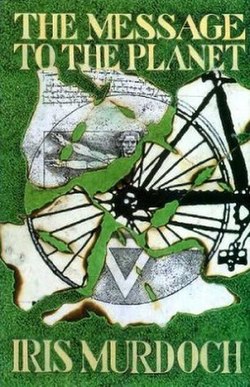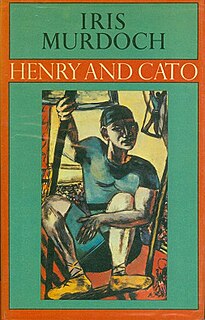
Dame Jean Iris Murdoch was an Irish and British novelist and philosopher. Murdoch is best known for her novels about good and evil, sexual relationships, morality, and the power of the unconscious. Her first published novel, Under the Net, was selected in 1998 as one of Modern Library's 100 best English-language novels of the 20th century. Her 1978 novel The Sea, the Sea won the Booker Prize. In 1987, she was made a Dame by Queen Elizabeth II for services to literature. In 2008, The Times ranked Murdoch twelfth on a list of "The 50 greatest British writers since 1945".
John Oliver Bayley, CBE, FBA, FRSL was a British academic, literary critic and writer. He was the Warton Professor of English at the University of Oxford from 1974 to 1992. His first marriage was to the novelist and philosopher Iris Murdoch.

The Sea, the Sea is a novel by Iris Murdoch. Published in 1978, it was her nineteenth novel. It won the 1978 Booker Prize.
John Barrington Wain CBE was an English poet, novelist, and critic, associated with the literary group known as "The Movement". He worked for most of his life as a freelance journalist and author, writing and reviewing for newspapers and the radio.

Under the Net is a 1954 novel by Iris Murdoch. Set in London, it is the story of a struggling young writer, Jake Donaghue. Murdoch's first novel, its mixture of the philosophical and the picaresque has made it one of Murdoch's most popular novels.
The Whitbread Awards (1971–2005), called Costa Book Awards since 2006, are literary awards in the United Kingdom, awarded both for high literary merit but also for works considered enjoyable reading. This page gives details of the awards given in the year 1974.
Peter J. Conradi is a British author and academic, best known for his studies of writer and philosopher, Iris Murdoch, who was a close friend. He is a Professor Emeritus of English at the University of Kingston and has been Visiting Fellow at Magdalen College Oxford and Research Fellow at University College London.

The Red and the Green is a novel by Iris Murdoch. Published in 1965, it was her ninth novel. It is set in Dublin during the week leading up to the Easter Rising of 1916, and is her only historical novel. Its characters are members of a complexly inter-related Anglo-Irish family who differ in their religious affiliations and in their views on the relations between England and Ireland.

Sacred and Profane Love is an oil painting by Titian, probably painted in 1514, early in his career. The painting is presumed to have been commissioned by Niccolò Aurelio, a secretary to the Venetian Council of Ten, whose coat of arms appears on the sarcophagus or fountain, to celebrate his marriage to a young widow, Laura Bagarotto. It perhaps depicts a figure representing the bride dressed in white, sitting beside Cupid and accompanied by the goddess Venus.

A Fairly Honourable Defeat is a novel by the British writer and philosopher Iris Murdoch. Published in 1970, it was her thirteenth novel.

The Bell is a novel by Iris Murdoch. Published in 1958, it was her fourth novel. It is set in a lay religious community situated next to an enclosed order of Benedictine nuns in Gloucestershire.

The Unicorn is a novel by Iris Murdoch. Published in 1963, it was her seventh novel.

The Message to the Planet is a novel by Iris Murdoch. Published in 1989, it was her twenty-fourth novel.

The Nice and the Good is a novel by Iris Murdoch. Published in 1968, it was her eleventh novel. The Nice and the Good was shortlisted for the 1969 Booker Prize.

An Unofficial Rose is a novel by Iris Murdoch. Published in 1962, it was her sixth novel.

The Sovereignty of Good is a book of moral philosophy by Iris Murdoch. First published in 1970, it comprises three previously published papers, all of which were originally delivered as lectures. Murdoch argued against the prevailing consensus in moral philosophy, proposing instead a Platonist approach. The Sovereignty of Good is Murdoch's best known philosophy book.

Henry and Cato is a novel by Iris Murdoch. Published in 1976, it was her eighteenth novel.

An Accidental Man is a novel by Iris Murdoch, which was published in 1971. It was her fourteenth novel.

The Time of the Angels is a philosophical novel by British novelist Iris Murdoch. First published in 1966, it was her tenth novel. The novel centres on Carel Fisher, an eccentric Anglican priest who is the rector of a London church which was destroyed by bombing during World War II. Fisher denies the existence of God and the possibility of human goodness in a post-theistic world. The novel, which has elements of Gothic fiction, received mixed reviews on its publication.

Sartre: Romantic Rationalist is a book by Iris Murdoch. Published in 1953 by Bowes & Bowes of Cambridge, it was Murdoch's first book and the first book about Jean-Paul Sartre's work to be published in English.

















